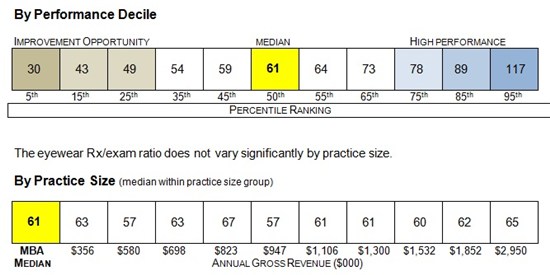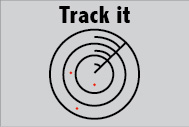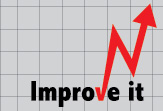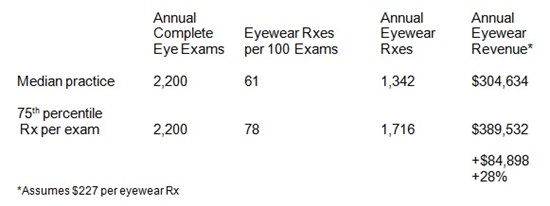By Thomas F. Steiner
Director of Market Research,
Review of Optometric Business

SYNOPSIS
Eyewear sales are the largest revenue source in most practices. Eyewear dispensed per 100 complete eye exams is a useful measure of a practice’s eyewear sales effectiveness.
ACTION POINTS
BENCHMARK IT. Compare MBA medians to your practice performance in critical areas.
TRACK IT. Office process and revenues that are tracked tend to improve because of it.
IMPROVE IT. Calculate your revenue gains if you reach the MBA 75th percentile.
APPLYING MBA METRICS: Since 2005, the Management & Business Academy (MBA), sponsored by Essilor, has assessed the financial performance of more than 1,800 independent optometric practices. The aggregate data from these assessments comprise the vast MBA database, which can explored at MBA-ce.com, a site open to all. A seminar resource, Key Metrics: Assessing Optometric Practice Performance, can be downloaded from the site.
A high proportion of the patients that most ODs see wear eyeglasses, and eyewear sales are the largest revenue source in most practices. The number of pairs of eyeglasses dispensed per 100 complete eye exams performed provides a useful measure of a practice’s eyewear sales effectiveness. It is an indicator of a practice’s eyewear capture rate and also of its effectiveness in selling eyeglasses to contact lens wearers and selling multiple pairs of eyewear.
Eyewear Rxes per complete exam is calculated by dividing the total number of eyewear Rxs delivered to patients in any time period (including both complete Rxes and new lenses in old frames) by the number of complete eye exams performed during the same period, then multiplying this value by 100.
Industry data show that one-third of the eyewear purchases of patients of independent eyecare professionals are made with other providers, usually optical retailers, whose main focus is selling eyeglasses. While “walk-out” represents enormous revenue loss to private eye doctors, just 23 percent of MBA practices ever track their eyewear sales capture rate.
Surveys show that another leading reason patients do not purchase eyewear on exam day is that their exam indicated no change to their prescription.
In typical OD offices, approximately 30 percent of complete eye exams are performed for contact lens patients, and just 20 percent of contact lens wearers purchase eyeglasses during their exam visit. The proportion of contact lens patients buying eyeglasses is the third most important variable affecting the eyewear per exam ratio.

Based on all independent ODs participating in the MBA assessment program, the median eyewear Rxes per 100 complete exams is 61. The ratio was stable between 2005 and 2013. The 10 percent of practices with the highest eyewear Rxes per 100 complete exams dispense 117 Rxes. These practices are atypical in that they more aggressively market their optical dispensaries and attract eyeglass buyers who receive exams from other providers. The 10 percent of practices with the lowest ratio produce just 30 eyewear Rxes per 100 exams.


Every well-managed practice should track eyewear Rxes per exam monthly and share the findings with staff. A practice with multiple locations should calculate the ratio separately for each location and it should be calculated separately for each OD in the practice.

Increasing the number of eyewear Rxes per 100 exams has a big impact on practice revenue. Increasing the ratio from the median of 61 eyewear Rxes per 100 exams to 78 (75th percentile performance) increases eyewear revenue by 28 percent, which translates to $84,898 in the median practice.

Action Plan
Here are the steps to uncover the sources of deficiency in eyewear Rxes per exam and to develop an action plan to increase the ratio:
Monitor key eyewear sales metrics
Key eyewear sales metrics include:
• Percentage of patients with an Rx change who do not purchase eyeglasses on exam day. Well managed practices can achieve a walkout ratio of 10 percent or less.
• Percentage of patients with no Rx change who purchase eyeglasses. Through effective presentation, this ratio can reach 70 percent or more.
• Percentage of contact lens patients who purchase eyeglasses on exam day. Twenty percent is typical, but the ratio can be increased to 33 percent or more.
• Percentage of patients buying multiple pairs of eyewear. Ten percent is typical, but a ratio of 25 percent is achievable.
Monitoring these metrics will isolate deficiencies to be addressed.
Evaluate the patient appeal of the dispensary
In some practices, the major problem driving down eyewear capture rate is ineffective merchandising. When patients conclude that their eyewear choices are limited at a practice or that the staff is unlikely to provide expert advice during a complex eyewear selection process, they may take their business elsewhere.
Recommend an eyewear update to contact lens patients
All contact lens patients should be encouraged to update their eyewear with a new frames style, a higher performance lens or both. This is particularly important for patients with an Rx change.
To eyeglass-only patients with no Rx change, educate about new frame and lens options
Office staff should be trained to never assume that patients with no Rx change will not want to purchase eyeglasses. Every patient should be encouraged to upgrade their current eyewear.
Encourage all eyeglass wearers to own and use a pair of glasses for indoor and outdoor use
To maximize comfort and vision, most people need different pairs of eyeglasses for indoors and outdoors, and all should be encouraged to own both types.
Related ROB Articles
Top Metric to Track: Complete Exams Per OD Hour
Top Metric to Track: Gross Revenue Per Complete Exam
The State of the Optometric Profession: Increase Demand Among Existing Patients
Thomas F. Steiner, Director of Market Research for ROB, has spent more than 25 years helping eyecare practices succeed, including pioneering the introduction of color contact lenses into optometry. To contact him: tnlsteiner@comcast.net

























